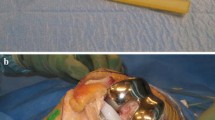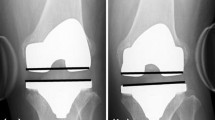Abstract
Introduction
To get balanced ligaments is generally accepted as a relevant prognostic factor after total knee replacement (TKR). The exact influence of the medial osteophytes on the medial collateral laxity has never been investigated. We hypothesized that the resection of the medial femoral and tibial osteophytes would increase the medial laxity during TKR.
Materials and methods
We studied 20 cases of varus gonarthrosis operated on for TKR under navigation control. Medial laxity before and after osteophyte resection were measured with the navigation system. The thickness of the resected osteophytes from the femur and the tibia was measured by comparing the pre-operative and post-operative coronal plain X-rays. Medial laxity before and after osteophyte resection were compared with a Spearman test at a 0.05 level of significance. Correlation between the difference in medial laxity and the thickness of the resected osteophytes was studied with the calculation of the Spearman correlation test at a 0.05 level of significance.
Results
The mean paired difference between pre-resection and post-resection laxity was 0.5° ± 1.0°; this difference was statistically significant but of little clinical relevance. There was no difference between pre- and post-resection medial laxity by 10 patients, a 1° difference in 9 patients, and a 2° difference in one patient. There was no correlation between the thickness of the resected osteophytes (femur, tibia and total) and the difference between pre- and post-resection medial laxity.
Conclusion
We demonstrated that the medial osteophytes had no clinically significant influence on the medial laxity during TKR. There is no need for routine medial osteophytes resection only for the purpose of ligamentous balancing during TKR.






Similar content being viewed by others
References
Baldini A, Scuderi GR, Aglietti P, Chalnick D, Insall JN (2004) Flexion-extension gap changes during total knee arthroplasty: effect of posterior cruciate ligament and posterior osteophytes removal. J Knee Surg 17:69–72
Bellemans J, D’Hooghe P, Vandenneucker H, Van Damme G, Victor J (2006) Soft tissue balance in total knee arthroplasty. Does stress relaxation occur perioperatively? Clin Orthop 452:49–52
Brage ME, Draganich LF, Pottenger LA, Curran JJ (1994) Knee laxity in symptomatic osteoarthritis. Clin Orthop 304:184–189
Engh GA (2003) The difficult knee. Clin Orthop 416:58–63
Jenny JY, Boeri C (2001) Computer-assisted implantation of total knee prostheses: a case-control comparative study with classical instrumentation. Comput Aided Surg 6:217–220
Matsuda Y, Ishii Y, Noguchi H, Ishii R (2005) Varus-valgus balance and range of movement after total knee arthroplasty. J Bone Joint Surg Br 87:804–808
Pottenger LA, Phillips FM, Draganich LF (1990) The effect of marginal osteophytes on reduction of varus-valgus instability in osteoarthritic knees. Arthritis Rheum 33:853–858
Saragaglia D, Picard F, Chaussard C, Montbarbon E, Leitner F, Cinquin P (2001) Mise en place des prothèses totales du genou assistée par ordinateur: comparaison avec la technique conventionnelle. Rev Chir Orthop 87:18–28
Seon JK, Song EK, Yoon TR, Bae BH, Park SJ, Cho SG (2006) In vivo stability of total knee arthroplasty using a navigation system. Int Orthop 31:41–48
Sparmann M, Wolke B, Czupalla H, Banzer D, Zink A (2003) Positioning of total knee arthroplasty with and without navigation support. A prospective, randomised study. J Bone Joint Surg Br 85:830–835
Victor J, Hoste D (2004) Image-based computer-assisted total knee arthroplasty leads to lower variability in coronal alignment. Clin Orthop 428:131–139
Whiteside LA, Saeki K, Mihalko WM (2000) Functional medial ligament balancing in total knee arthroplasty. Clin Orthop 380:45–47
Conflict of interest statement
No funds were received in support of this study
Author information
Authors and Affiliations
Corresponding author
Rights and permissions
About this article
Cite this article
Jenny, JY., Boeri, C. & Schneider, L. Medial knee osteophytes have little influence on the medial collateral laxity during total knee replacement. Eur J Orthop Surg Traumatol 18, 339–343 (2008). https://doi.org/10.1007/s00590-008-0311-z
Received:
Accepted:
Published:
Issue Date:
DOI: https://doi.org/10.1007/s00590-008-0311-z




